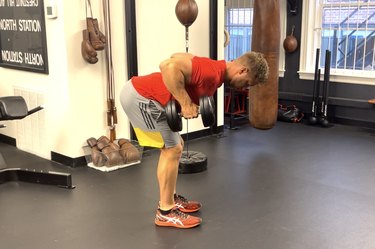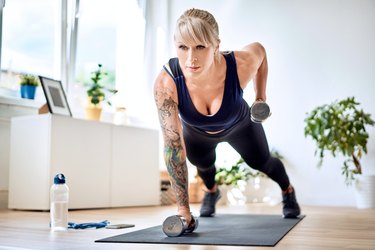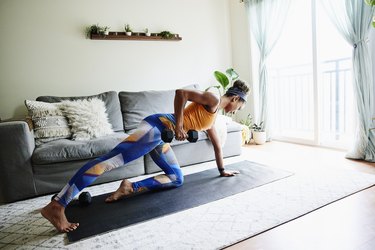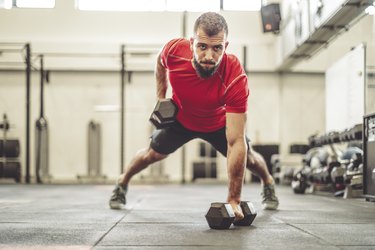
The bent-over dumbbell row is a compound free-weight exercise that engages most of the muscles on the backside of the upper body. It's a classic lifting exercise that trains one of the fundamental human movement patterns: pulling.
What are the main dumbbell row muscles worked? The move primarily builds strength and depth in the back muscles, Parker Cote, CPT, a Boston-based certified trainer, tells LIVESTRONG. It targets multiple muscles in the back, including the latissimus dorsi, rhomboids and erector spinae.
Video of the Day
But it also works muscles in the shoulders and arms, including the trapezius, posterior deltoids and biceps. "It is a very efficient move because, asa multi-joint, compound exercise, it recruits a large amount of muscle fibers," Cote adds.
Bent-Over Dumbbell Row
- Stand with your feet hip-width apart, holding a dumbbell in each hand by your sides, palms facing in toward your body.
- Push your hips back to hinge your torso forward and soften your knees. Let the weights hang straight down in front of your knees. Brace your core and think about keeping your back completely flat. Your torso should be as close to horizontal as you can get it without rounding it or jerking as you lift.
- Row the dumbbells up toward your ribcage, bending your elbows as you do so that they move behind your torso. Squeeze your shoulder blades together and pause at the top of the movement.
- Keep your core and spine stable as you extend your arms and lower the dumbbells so that they hang by your knees.
Tip
Keeping your hips as far back as possible will eliminate any stress in your lower back.
Bent-Over Dumbbell Row Muscles Worked
The bent-over DB row targets muscles in your upper and middle back — but it also works the shoulders, arms and core.
1. Latissimus Dorsi
Running down the sides of your back, your latissimus dorsi, or lats, is the primary muscle worked in dumbbell rows (DB rows).
During each row, lead with your elbows. This helps you create as much shoulder extension. "The elbows should clear the back to ensure a full contraction of the back muscles. Stopping short limits your bent-over row benefits," Cote says.
2. Rhomboids, Posterior Deltoids and Trapezius
Remember when we said that the entire upper body gets involved in this move? We weren't kidding.
The rhomboids and trapezius are muscles in the upper back that are responsible for pulling the shoulder blades down and together. The posterior deltoids are the muscles on the backs of the shoulders. All of them assist in the movement as you row the weight and pull your shoulder blades back and together.
Even when you're not rowing, you should be engaging the rhomboids and trapezius. Drawing your shoulder blades together, called retraction, is basically the opposite of letting them round or slouch forward.
Keeping your shoulder blades retracted gives your arm and back muscles a solid base from which to generate force and increases shoulder girdle stability, which may help reduce your risk of a shoulder injury when performing this exercise.
Don't let your shoulders go loose at any point in the exercise.
3. Biceps Brachii
Located on the front of your upper arm, your biceps brachii — biceps for short — flexes your elbow. "The job of the biceps is to contract as the arm bends," Cote explains.
The biceps are considered a secondary mover in this exercise, meaning they help assist the movement but shouldn't be the main muscle group feeling the burn.
"Ideally when you perform this move, you'll feel minimal biceps involvement," he says. "If you feel too much in the biceps, simply lighten the weight."
Visualizing the shoulder blades squeezing together and the rhomboids contracting at the top of the movement can also help minimize the role of the biceps, he adds.
4. Erector Spinae
The primary muscles responsible for keeping your spine correctly aligned in the bent-over or hinged position are your erector spinae.
This group of eight muscles runs from the base of your pelvis to the back of your skull and works hard to maintain optimal posture while you work out.
Rounding your back places an unnecessary and potentially injurious strain on these muscles and the underlying spinal structures. To minimize your risk, focus on keeping your lower back only slightly arched, your chest held high and your core engaged.
5. Transverse Abdominis
Along with the erector spinae muscles, the transverse abdominis — the innermost abdominal muscle — works like an internal weight belt to brace your spine and keep your torso from wobbling.
Together, these muscles cover all 360 degrees of your core. Again, minimizing the dip in your lower back can help you best activate the transverse abdominis muscle.
3 Benefits of the Bent-Over Dumbbell Row
1. Improved Posture
"Having a strong back is important to balance out the front of the torso strength-wise," Cote says. "Imbalances in front-to-back of the body strength result in poor posture."
If you sit all day, this is extra important: When your back is rounded forward, your chest muscles contract (shorten) and your upper back muscles stretch (lengthen). Exercises that lengthen the chest muscles and contract the upper-back muscles help balance things out, improving posture and preventing muscle imbalances that can lead to injury, Cote says.
2. Functional Strength
The DB row trains a movement pattern you use in everyday life, which means it's highly functional. Because it requires movement at more than one joint — both the shoulder and elbow — it's considered a compound exercise, Cote says.
"This allows a higher resistance to be used when compared with its single-joint counterparts, such as a straight-arm cable pulldown." Translation: You can load up the weight, making the row a great exercise for building strength and muscle mass.
3. Core Stability
It may not look or seem like a core exercise, but the bent-over row asks a lot from your midsection — both front and back. You have to fully engage your core to maintain a flat back in the hinged position. (In fact, compound exercises in general are some of the best core exercise. Because they involve more joints and muscle groups, the harder your core has to work to keep everything stable.)
"Keeping the core tight and contracted is arguably the most important part of the exercise," Cote says. "From an injury prevention standpoint, keeping the abs flexed through the duration of the move will protect your lower back from becoming overly involved."
As you row and keep your spine stable in the bent-over or hinged position (no arching, rounding or twisting) you're training core stability big time.
Variations of the Bent-Over Dumbbell Row and Muscles Worked
The bent-over DB row is the starting place for tons of different dumbbell row variations — all of which have unique benefits and work your muscles slightly differently.
For example, single-arm variations let you target each side of your body separately (and also increase how hard your core has to work to keep you stable).
Meanwhile, supported rows, in which you place one hand (or your entire chest and torso) on bench for support, take some of the stress out of your core. And because, with these variations, you don't have to work so hard to stabilize your body, you're able to pull more weight and better isolate your back with each rep.


